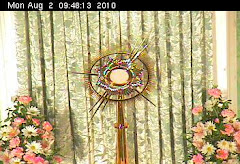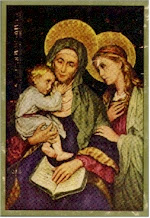
NOW YOU SEE IT, THEN YOU DON'T!

The atmosphere of Lent has a solemn mood. The penitential colour of purple is visible in vestments and church decoration. The sanctuary is devoid of its usual festive decor.
In some churches, beginning around the year 900, one large cloth was hung between the people and the altar from the beginning of Lent. This was done to conceal the heavenly glory depicted by images of Saints and Crosses with the figure of the risen and triumphant Christ. Since about 1600, the veiling was limited to Passiontide which begins on the 5th Sunday of Lent, this Sunday was originally called 'Passion Sunday'.
The custom of veiling images of the Saints and Crucifixes in church with a purple cloth symbolises sadness and mourning - On the 5th Sunday of Lent (Year B) the final words of the Gospel are 'At that they picked up stones to throw at Jesus, but he hid himself.' (John 8: 59)
This weekend, along with other Catholic churches throughout the world, we at St Ann's followed the 'Passiontide' practice of veiling the crucifix and statues in our church. Our beautiful large, 'Christus Rex' crucifix behind the altar showing Christ in Glory as King and High Priest is not an easy object to veil but thanks to two of our parishioners and their ingenious scheme for raising the veil on extendable poles and securing it to rest on two brackets, it was successfully accomplished (and within health and safety guidelines too!)
The crucifix will remain covered until the end of the celebration of the Lord's Passion on Good Friday. Images remain covered until the beginning of the Easter Vigil.









1 comment:
Father, thank you for the explanation here. When our son asked me last Sunday why the statues were covered I found myself only able to say 'it's tradition'. When he gets home from school today I will show him the website and be able to read him your explanation. I too have learnt something new today - thank you!
Post a Comment